Discover how Ansys Fluent can accurately predict the thickness of surface deposition with its powerful simulation capabilities.
Understanding the Importance of Surface Deposition Thickness
Surface deposition thickness plays a critical role in various industries, such as manufacturing, aerospace, and automotive. It refers to the amount of material that accumulates on a surface over time due to various factors like erosion, corrosion, or deposition. Understanding and predicting surface deposition thickness is crucial for ensuring the efficiency, durability, and safety of critical components.
Excessive surface deposition can lead to reduced performance, increased maintenance costs, and even failure of equipment. On the other hand, insufficient deposition can result in inadequate protection, leading to damage and premature wear. Therefore, accurately predicting surface deposition thickness is essential for optimizing design, maintenance, and operational strategies.
By using Ansys Fluent, a powerful simulation software, engineers and researchers can accurately predict surface deposition thickness and gain insights into the underlying phenomena. This enables them to make informed decisions, improve designs, and optimize processes to achieve desired performance and longevity.
Introducing Ansys Fluent: A Simulation Software for Surface Deposition
Ansys Fluent is a cutting-edge simulation software developed by Ansys Inc. It is specifically designed for solving complex fluid flow and heat transfer problems in various industries. With its advanced capabilities, it has become a go-to tool for engineers and researchers working on predicting surface deposition thickness.
Ansys Fluent uses computational fluid dynamics (CFD) techniques to simulate the fluid flow and deposition phenomena. It can accurately model the behavior of different fluids, including gases and liquids, and their interactions with solid surfaces. By incorporating various physical and chemical models, Fluent can simulate the deposition process and provide insights into the thickness and distribution of deposited material.
The user-friendly interface of Ansys Fluent allows engineers to set up and solve deposition problems efficiently. It provides a wide range of pre-defined models, solvers, and post-processing tools, making it suitable for both beginners and experienced users. With its robust simulation capabilities, Ansys Fluent empowers engineers to predict and optimize surface deposition thickness in a time-efficient and cost-effective manner.
Key Features and Capabilities of Ansys Fluent for Predicting Surface Deposition Thickness
Ansys Fluent offers a comprehensive set of features and capabilities that make it a powerful tool for predicting surface deposition thickness. Some key features include:
1. Multiphase Flow Modeling: Ansys Fluent can simulate multiphase flows, allowing engineers to study the behavior of different fluid phases and their interactions with surfaces.
2. Particle Tracking: The software enables the tracking of particles or droplets in the fluid flow, providing valuable information about their deposition patterns and thickness.
3. Chemical Reactions: Ansys Fluent can model chemical reactions between the fluid and the surface, allowing engineers to analyze the impact of reactions on deposition thickness.
4. Heat Transfer Analysis: The software includes advanced heat transfer models, enabling engineers to study the thermal effects on deposition and predict temperature distributions.
5. Post-Processing Tools: Ansys Fluent provides a range of post-processing tools, such as contour plots, animations, and data visualization, to analyze and interpret the simulation results.
These features, combined with the accuracy and reliability of Ansys Fluent, make it an indispensable tool for predicting and optimizing surface deposition thickness in various industries.
Step-by-Step Guide to Predicting Surface Deposition Thickness using Ansys Fluent
Predicting surface deposition thickness using Ansys Fluent involves several steps. Here is a step-by-step guide to help you get started:
1. Geometry Creation: Start by creating a 3D model of the surface or component where deposition will occur. Use Ansys Discovery to create the geometry. The project can be easily managed using Ansys workbench as shown below in Figure 1.
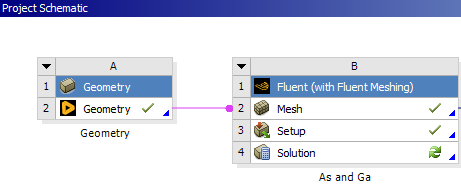
Figure 1. Project schematic in Ansys Workbench
2. Mesh Generation: Generate a mesh for the geometry to discretize it into smaller elements. Ansys Fluent supports various meshing techniques, such as structured, unstructured, and hybrid meshing. Figure 2 shows a polyhedral mesh generated using Fluent meshing.
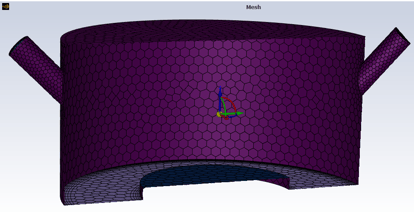
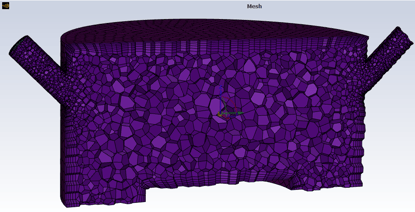
(a) (b)
Figure 2. Surface mesh (a) and Volume mesh (b)
3. Material Properties: Define the properties of the fluid and surface materials involved in the deposition process. This includes density, viscosity, thermal conductivity, and deposition characteristics.
4. Boundary Conditions: Set up the boundary conditions for the fluid flow, including inlet velocity, pressure, and temperature. Define the surface where the deposition will occur as a deposition boundary.
5. Model Setup: Choose the appropriate models i.e., species transport, multiphase flow model, and/or particle tracking method in Ansys Fluent. Specify the relevant deposition models, such as mass transfer and surface reactions. As shown in Figure 3, two gas species are injected into the mixing chamber. The gas mixes and reaches the deposition surface where a surface reaction leads to the deposition of material. The remaining gas exits the reaction chamber via the bottom outlet. The deposition surface is also rotating in a counter-clockwise direction to achieve a uniform deposition.
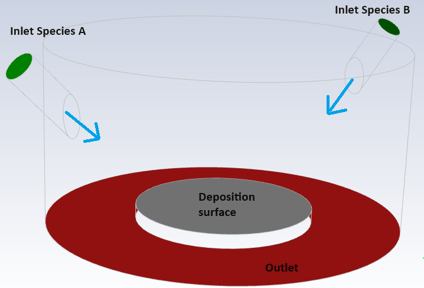
Figure 3. Problem description and boundary conditions
6. Simulation Setup: Configure the solver settings, time steps, and convergence criteria. Simulate to obtain the deposition thickness distribution over time.
7. Post-Processing: Analyze the simulation results using Ansys Fluent’s post-processing tools. Generate contour plots, animations, and other visualizations to gain insights into the deposition thickness and its distribution. Figure 4, shows the velocity vectors inside the chamber. Figure 5, shows the rate of material deposition on the surface and Figure 6 shows the deposition thickness in millimeters.
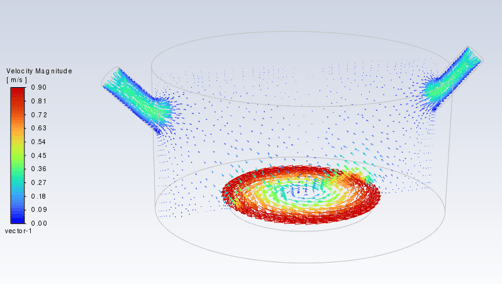
Figure 4. Gas flow vectors
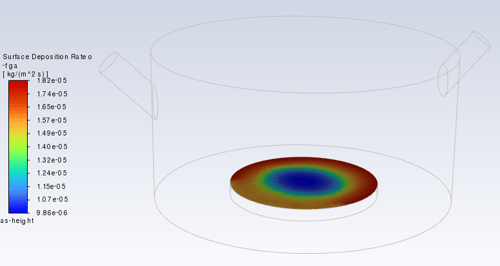
Figure 5. Material deposition rate
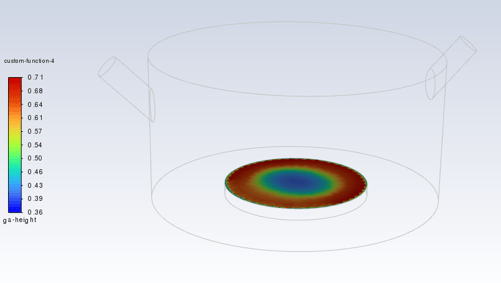
Figure 6. Thickness of deposition
By following these steps and leveraging the capabilities of Ansys Fluent, engineers can accurately predict surface deposition thickness and optimize their designs and processes accordingly.
Real-World Applications and Benefits of Predicting Surface Deposition Thickness
The prediction of surface deposition thickness using Ansys Fluent has numerous real-world applications and benefits across various industries. Some notable examples include:
1. Aerospace Industry: Accurate prediction of surface deposition thickness helps in designing and maintaining aircraft components, such as turbine blades, heat exchangers, and engine parts. It allows engineers to optimize the cooling systems, prevent harmful deposits, and enhance the overall performance and efficiency of aircraft.
2. Power Generation: Predicting deposition thickness is crucial for power plants that rely on heat exchangers, boilers, and condensers. By understanding the deposition behavior, engineers can optimize cleaning schedules, improve heat transfer efficiency, and reduce downtime and maintenance costs.
3. Oil and Gas Industry: Pipelines, valves, and other equipment in the oil and gas industry are prone to deposition due to the presence of impurities in the fluids. Accurate prediction of deposition thickness helps in optimizing the flow rates, preventing blockages, and ensuring the safe and efficient operation of the infrastructure.
4. Automotive Industry: Engine components, such as intake manifolds and exhaust systems, can experience deposition of carbon and other contaminants. By predicting deposition thickness, engineers can design efficient cleaning strategies, reduce emissions, and improve the performance and longevity of automotive systems.
The benefits of predicting surface deposition thickness using Ansys Fluent are far-reaching. It enables engineers to optimize designs, reduce maintenance costs, improve efficiency, and enhance the reliability and safety of critical components.
In conclusion, Ansys Fluent is a powerful simulation software that empowers engineers to accurately predict surface deposition thickness. By understanding its importance, introducing Ansys Fluent, exploring its key features, and following a step-by-step guide, engineers can leverage its capabilities to optimize designs, processes, and maintenance strategies. The real-world applications and benefits of predicting surface deposition thickness make it an invaluable tool for various industries.

